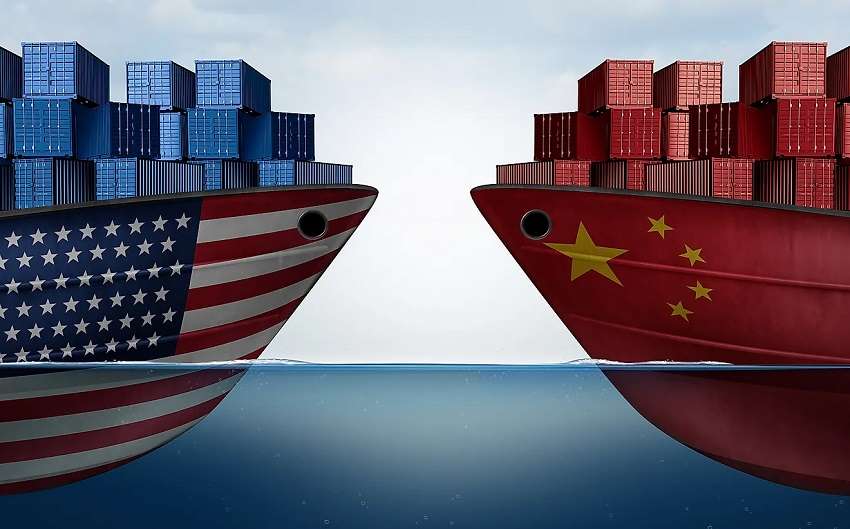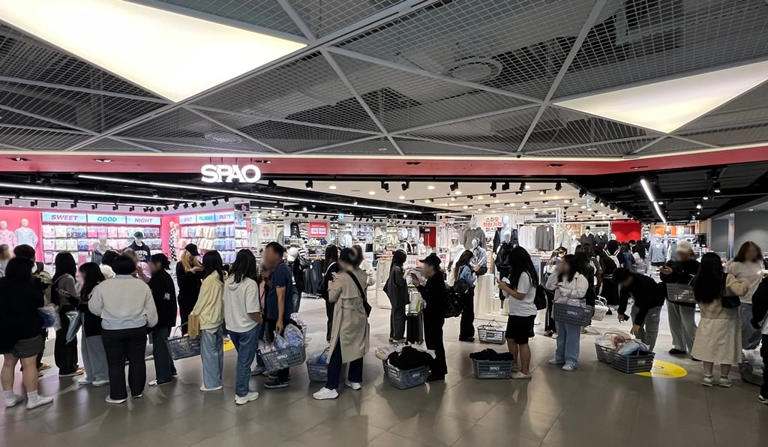FW
Projecting a slowdown, Bain & Co forecasts,China’s luxury sales will decrease by 12 per cent from 2023, with sales primarily being driven by high-net-worth individuals possessing investible assets exceeding 10 million yuan ($1.4 million).
This shift emphasises a renewed focus on catering to key clientele, as highlighted by Tan, a representative from Bain & Co. This reorientation comes in response to a concerning trend, a surge in product returns, prompting luxury brands to reevaluate their strategies within the Chinese market.
During China's major shopping event last November, renowned luxury labels such as Ralph Lauren Corp, Burberry Group Plc, and Richemont SA's Net-A-Porter faced an unprecedented wave of returns and cancellations, with some experiencing up to 75 per cent of sales value being reversed.
The exceptionally high rate of returns, well beyond the norm of 20 per cent to 30 per cent in the luxury industry, persisted even after China transitioned from its strict COVID Zero policies over a year ago. This trend poses a challenge to fashion labels operating in the world's second-largest economy, particularly as the middle class now seeks discounts or refrains from high-end purchases amid economic headwinds.
The situation worsened in the first quarter of the current year, with Tmall return and cancellation rates soaring for several luxury brands compared to the same period in previous years. This included notable names like Brunello Cucinelli SpA, Marc Jacobs, Chloé, Ralph Lauren, and Mulberry Group PLC.
Mark Tanner, Managing Director, China Skinny, suggests, the softening of luxury demand may encourage opportunistic behavior, with individuals leveraging luxury items for status before returning them at no cost.
While Tmall plans to continue collaborating with luxury brands, the return issue persists, exacerbated by shoppers exploiting promotional campaigns to secure discounts, even if they intend to return purchased items later. This behavior inflates initial sales figures but doesn't translate into sustained revenue.
However, luxury labels at the highest echelons, such as Hermes International SCA, Chanel, and Dior, are limiting their reliance on e-commerce channels and refraining from extensive sales campaigns, instead focusing on cultivating relationships with affluent clientele.
Nevertheless, the allure of Tmall's extensive reach continues to attract some luxury brands, despite the risk of tarnishing their image through frequent participation in promotions. With online orders accounting for a significant portion of China's high-end market revenue, premium brands are compelled to navigate the challenges posed by e-commerce platforms, investing in personalised services and exclusive experiences to nurture long-term relationships with wealthy customers.
A leading additive manufacturer Stratasys will apply its newly launched Direct-to-Garment (D2G) solution on its J850 TechStyle printer for the Urban Tattoo denim collection to be launched at the Texprocess exhibition in Frankfurt, Germany on April 23.
The D2G technology enables manufacturers to incorporate full-color, multi-material 3D printing directly onto fully assembled garments, including denim, cotton, polyester, and linen. Through this innovation, fashion brands can create personalised and bespoke designs, catering to individual preferences, sizes, and styles.
Zehavit Reisin, Senior Vice President, Commercial Solutions, Stratasys, says, the technology enables brands to infuse more character into their clothing lines while adopting sustainable business practices that resonate with consumers.
Enabling customisation of various garment types and sizes, the D2G tray kits are available in two sizes. This technology aims to reduce material waste and streamline the production process.
A result of collaboration with renowned designers such as Karim Rashid and Travis Fitch, the Urban Tattoo collection transforms everyday garments into unique pieces of wearable art. According to Naomi Kaempfer, Creative Director, Stratasys, the collection enhances the emotional connection between the clothing and its wearer by adding layers of stories and symbolism to garments.
Data from InvestingPro shows, with a market capitalisation of approximately $694.02 million, Stratasys navigates through a challenging period with a negative P/E ratio of -5.48, reflecting the company's current lack of profitability. Despite this, the company's gross profit margin remains strong at 44.53 per cent, indicating a robust underlying business in the last twelve months as of Q4 2023.
Launched on April 17, 2024 in Barcelona, the Barcelona Bridal Fashion Week (BBFW) 2024 will showcase the latest creations in bridal fashion. To run till April 21, this year’s edition has reported a 14 per cent rise in the number of participants. It features 400 brands from 35 countries.
The event commenced with the inauguration of an eye-catching artistic installation created by theater group La Fura dels Baus. Named, 'Barcelona goes Bridal!, the six-meter-tall rotating structure on Maria Cristina Avenue has 30 wedding dresses from Catalan brands hanging off it.
The first collection to appear on the runway was from Jesús Peiró, with 37 international designers featuring from Wednesday to Sunday.
In parallel to the catwalk, BBFW is also hosting a trade show at the Montjuïc site. This trade show has reported a 14 per cent rise in attendees with 400 exhibitors from 35 countries participating in it. The fair is expected to generate an economic impact of €61.5 million.
Stoll, a leader in textile machinery, has launched the CMS 503 ki L, a 50" knitting machine tailored for the volume market. In an industry marked by rapid fashion shifts and intense price competition, manufacturers face the challenge of meeting diverse demands economically.
The CMS series by Stoll has long been recognized for its cost-effective solutions, catering to high-volume production while maintaining flexibility in design. The latest addition, the CMS 503 ki L, boasts a wider working width, denoted by the "L" for "Large," allowing for the creation of extensive motif formats and accommodating an extended size range.
Michael Händel, Vice President Sales & Service at Karl Mayer Stoll Textilmaschinenfabrik GmbH, highlights the significance of this development in response to the global trend toward larger sizes, particularly in markets like America, Asia, and Europe. The machine's enhanced capabilities position manufacturers to meet evolving consumer preferences efficiently.
Technological advancements, including the Multiflex take-up and spring-loaded latch needles, ensure optimal fabric width fixation, reduced waste, and improved cost-efficiency. Additionally, as part of the Knitelligence machine generation, the CMS 503 ki L is equipped to meet the demands of the digital era, offering automation possibilities, transparency, and shorter production cycles.
With a proven track record of reliability and performance, Stoll's CMS series continues to garner praise, with representatives boasting over 100,000 working hours. The unveiling of the CMS 503 ki L will take place at ITMA ASIA + CITME 2024 in Shanghai, where it will demonstrate its capabilities at the Karl Mayer Group booth, showcasing its potential to revolutionize high-volume knitting production.
Sympatex, a global leader in sustainable membranes, is showcasing its latest innovations at the Functional Fabric Fair in Portland (booth 312) from April 17th to 18th, 2024.
The company, renowned for its commitment to environmental responsibility and high-performance materials, is unveiling a diverse range of sustainable solutions aimed at transitioning the textile industry towards circularity. A focal point of Sympatex's presentation is its dedication to PFAS freedom, acknowledging the environmental risks associated with these chemicals and advocating for their elimination from non-essential applications.
Sympatex's membranes have been PFAS-free since its inception in 1986, with a transition towards fluorine-free C0 DWR since 2008. Annual tests and random sampling consistently confirm the absence of PFAS residues, aligning with the company's commitment to delivering PFAS-free products.
At the forefront of its innovations is a collaboration with e.dye, introducing solution-dyed polyester fabrics that significantly reduce water consumption, chemical usage, and carbon dioxide emissions. Kim Scholze, CSO of Sympatex, describes this partnership as a paradigm shift in textile dyeing, emphasizing the environmental benefits of solution dyeing.
Anja Palic, Product Management at Sympatex, highlights the advantages of solution dyeing, including exceptional color fastness and reproducibility. Additionally, Sympatex presents Tokyo Fiber2Fiber Spring AS, a sustainable alternative to traditional bottle recycling, crafted from chemically recycled waste.
With impending regulations from the European Commission mandating the use of recycled plastic components, Sympatex's innovations address the industry's need for premium-quality recycled fibers.
Functional Fabric Fair Spring serves as a premier sourcing destination for the outdoor and activewear industry, offering a glimpse into the future of performance fabrics and trends shaping the 2025/2026 Spring season. Open exclusively to industry professionals, the event underscores the industry's collective efforts towards sustainability and innovation.
The world's leading technical textiles and nonwovens manufacturers and technology providers will gather at the Hightex 2024 Exhibition in Istanbul, Turkey, from June 4th to 8th, 2024. This premier event, the first and only of its kind in Turkey, is expected to attract a record number of attendees, including industry representatives and global buyers.
Technical textiles, despite their unfamiliar name, are woven into the very fabric of our lives. From medical applications and automobiles to clothing and agriculture, these versatile materials play a crucial role in diverse sectors. In fact, technical textiles now account for a staggering 45-50 per cent of the traditional textile industry.
Experts predict continued strong growth for technical textiles. A recent report by Grand View Research Inc. forecasts the global technical textile market to reach a value of $272.33 billion by 2030, reflecting a healthy compound annual growth rate of 4.7 per cent.
The high level of interest in Hightex 2024 underscores the sector's dynamism and the emphasis placed on innovation. Technical textiles are poised for even deeper integration into various industries and our daily lives. This exhibition presents a unique opportunity for industry leaders to shape the future of this exciting field.
Hightex 2024 will bring together leading manufacturers and suppliers with industry professionals. Attendees can expect to see the latest advancements in technical textiles across a wide range of applications, including medical, automotive, aerospace, hygiene, agriculture, food, construction, smart textiles, and geotextiles.
Hightex 2024 goes beyond simply showcasing products. It fosters collaboration and networking opportunities for exhibitors. Visitors will gain valuable insights into the latest trends, enabling them to develop innovative products and craft future-proof strategies.

American consumers are opening their wallets again, with retail sales experiencing a modest uptick in recent months. According to the US Census Bureau, sales rose 0.7 per cent in March 2024 compared to February, and are up 4.0 per ent year-over-year.
However, the picture within the fashion sector is less clear. While overall retail sales data lumps fashion in with other categories, anecdotal evidence suggests a mixed bag. Some retailers report strong demand, while others continue to grapple with excess inventory from pandemic shutdowns.
Growth drivers unclear
The reasons behind the overall retail growth are multifaceted. Some economists point towards pent-up demand as consumers return to pre-pandemic spending habits. Others cite rising wages and increased household savings as factors. For the fashion sector specifically, it's difficult to pinpoint exact growth drivers. There could be a delayed response to reopening, with people refreshing their wardrobes after staying home for so long. Additionally, a focus on comfortable and casual attire, a trend that boomed during lockdowns, might be persisting. Moreover, wage growth in some sectors could put more money in consumers' pockets, boosting spending. With increased focus on travel and social gatherings, there could be a rise in demand for new clothes. Also, e-commerce continues to thrive, offering convenience and potentially boosting sales.
Fashion's foggy future
However, the outlook for the fashion sector is uncertain. While some reports suggest increased spending on apparel, others indicate a cautious consumer opting for essentials over discretionary purchases. Rising inflation and economic concerns could further dampen spending on non-essential items like fashion.
The impact on garment imports is difficult to predict. It's possible that rising sales could lead to increased imports to meet demand. However, it's also possible that retailers are simply selling through existing inventory built up during the pandemic.
Short-term vs long-term outlook
The short-term outlook for retail sales remains cautiously optimistic. With rising gas prices potentially dampening discretionary spending in other areas, consumers might shift their budgets towards apparel. However, inflation and potential interest rate hikes could act as headwinds later in the year.
The long-term picture is even more uncertain. The global supply chain continues to face disruptions, which could impact both the availability and cost of clothing. Additionally, consumer spending habits could evolve as economic factors change.
Overall, the US retail sector is showing signs of recovery, but the fashion segment presents a complex picture. While some growth is likely, the full extent and its drivers remain to be seen.

The story of Shein's soaring profits in 2023 presents a fascinating paradox. While a growing number of consumers, particularly millennials and Gen Z, express a desire for sustainable clothing, fast fashion giants like Shein are experiencing tremendous financial success. This raises several key questions.
Eco-conscious yet fast fashion obsessed
The core tension lies in the seemingly contradictory behavior of consumers, particularly millennials and Gen Z. Surveys like the one by The New Consumer and Coefficient Capital suggest a strong desire for environmentally friendly products, with over half of Shein's customers prioritizing such aspects. Additionally, 67 per cent reportedly express willingness to pay more for sustainable garments. However, research from Sheffield Hallam University reveals a different reality, 90 per cent of Gen Z respondents, despite their concern for sustainability, still resort to fast fashion purchases.
Indeed, fast fashion's allure lies in its affordability, with Shein's average unit price at a mere $7.90 in 2021. This affordability trumps stated preferences, as evidenced by the continued success of fast fashion companies despite their environmental and ethical shortcomings. Sustainable clothing often comes with a higher price tag, creating a barrier for some. This disconnect is a classic case of "stated preferences vs. revealed preferences" – a difference between what people say they want and what they actually do. Fast fashion offers a quick and easy way to update wardrobes, fueled by constant new trends and readily available online shopping options. Sustainable alternatives may require more research and effort to find.
Table: Revenue estimates of top global fast fashion brands
Shein
2021: $15.7 billion (estimated)
2022: $22.7 billion (estimated)
2023 (projected): Revenue on track to surpass H&M and Zara combined (possibly exceeding $58.5 billion)
Inditex Group (Zara)
2021: €37.0 billion ($42.3 billion)
2022: €30.7 billion ($35.4 billion)
2023 (YTD - first half): €18.3 billion ($21.1 billion)
H&M (H&M Group Reports)
2021: SEK 186.8 billion ($21.0 billion)
2022: SEK 198.9 billion ($22.7 billion)
2023 (YTD – Q1 to Q3): SEK 164.0 billion ($18.8 billion)
The data highlights, Shein's revenue has seen significant growth, potentially surpassing Zara and H&M combined in 2023. Zara's revenue (as part of Inditex group) shows some fluctuation but remains substantial. H&M's group revenue has seen a modest increase. It maybe noted Shein’s data are estimates and projections, and revenue figures for Zara and H&M are for their parent groups.
The credibility of sustainability claims
Surveys claiming a rise in eco-conscious consumers need to be viewed with a critical eye. While interest may be genuine, factors like affordability and lack of readily available sustainable alternatives can hinder purchase decisions. Additionally, ‘greenwashing’ by companies further erodes trust. Shein's factory tour campaign, for instance, received a lukewarm reception due to a lack of transparency. While awareness of sustainability is growing, there's still a gap in understanding the true environmental and ethical costs of fast fashion.
The core demographic for Shein is millennials and Gen Z. This generation is often portrayed as socially conscious, yet their buying habits paint a more complex picture. Possible explanations for this seemingly contradictory behavior include:
• Prioritization: Sustainability may not be the top priority for everyone. Other factors like style, trendiness, and affordability may outweigh environmental concerns.
• Greenwashing: Fast fashion companies like Shein's attempt to portray themselves as environmentally conscious through PR campaigns can create confusion. Consumers may be unsure of genuine sustainable practices vs. marketing tactics.
The future a balancing ct
The future of fast fashion seems to lie in a delicate balancing act. Companies like Shein acknowledge the importance of sustainability, evidenced by their pledges to invest in environmentally friendly practices and improve labor conditions. However, the success of these initiatives remains unclear. Here are some potential directions:
Increased transparency: Consumers crave information about a product's environmental impact and origin. Greater transparency in supply chains can rebuild trust. Fast fashion giants may be acknowledging the sustainability concerns. Shein's pledges to invest in eco-friendly practices and improve labor conditions suggest a potential shift towards a more responsible model.
Sustainable innovation: Technological advancements in fabric production and recycling can pave the way for eco-friendly yet affordable garments.
Shifting consumer behavior: Promoting mindful consumption and encouraging a "buy less, buy better" mentality can contribute to a more sustainable fashion ecosystem. Bridging the gap requires conscious consumerism. True change relies on actively seeking sustainable options, even if they come at a slightly higher price. Additionally, supporting second-hand clothing stores can be a more environmentally friendly alternative.
The onus lies not just on fast fashion giants but also on consumers. Educating ourselves about sustainable options and prioritizing quality over quantity are crucial steps towards a more balanced future for fashion. The dichotomy between consumer desires and buying habits highlights the complexities surrounding fast fashion. While fast fashion profits soar, the future remains uncertain. The rise of consumer awareness, innovation in sustainable fashion, and potential regulations could tip the scales towards a more sustainable future for the industry.
Exports of Cotton yarn, fabrics and made-ups from India increased by 6.78 per cent Y-o-Y in Mar’24, notes Sunil Patwari, Chairman, Cotton Textiles Export Promotion Council (TEXPROCIL). They also registered a 6.71 per cent Y-o-Y rise during FY’24, adds Patwari.
After being under pressure for more than a year, textile and apparel (T&A) exports grew by 6.91 per cent Y-o-Y during Mar’24. However for the entire FY’24, these exports contracted by 3.24 per cent
On the other hand, India’s apparel exports, which increased by 1.7 per cent Y-o-Y in Mar’24 declined by 10.25 per cent during FY24.
This growth in India’s cotton textiles last financial year despite geo-strategic challenges shows the resilience of the Indian textile industry. To sustain this growth, the new Central government needs to address issues such as cotton prices and preferential access in key markets, opines Patwari.
Various farmer associations and industry stakeholders’ in Zimbabwe have called for increased value addition to raw cotton to convert it into finished products, to revitalise the industry.
At the launch of 2021/22 cotton marketing season in Mahuwe, Engineer Chris Murove, CEO, Cotton Council of Zimbabwe (CCPZ) said, this move will not only benefit cotton farmers but also boost the extraction and refinement of cooking oil once the cotton farmer has access to their seed and lint. The remaining cotton cake can be used to manufacture feed for beef and dairy cattle, he added.
Dr Anxious Masuka, Minister of Lands, Agriculture, Fisheries, Water and Rural Development, also urged stakeholders to embrace cotton value addition, as the country journeys towards industrialising rural communities.
Overall, local Zimbabwean cotton industry processes about 20 percent of its lint production. The Government ensures that the local textile industry’s lint requirements are met by ensuring that each ginner reserves 30 per cent of lint production for local consumption.
Exporting shirts from processed cotton would have helped Zimbabwe boost revenues from the sector by 424 per cent to $219 million, from the US$42 million netted in 2023, said Masuka.
The country also exported cotton linters worth $7,318,456 and yarn worth $2,596,966 during the year. Had it exported cotton linters, cotton yarn and shirts it would have made a lot of revenue, he added.












